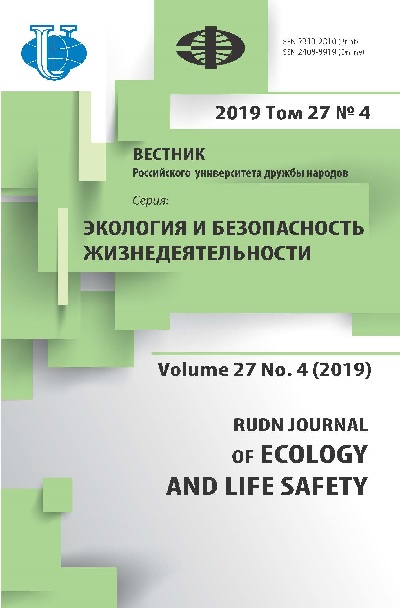Estimation of various factors impact on the area of oil patches in the Middle Volga region
- Authors: Volkova N.I.1, Naumov V.S.1, Plastinin A.E.1, Zakharov V.N.1
-
Affiliations:
- Volga State University of Water Transport
- Issue: Vol 27, No 4 (2019)
- Pages: 325-336
- Section: Environmetal defence
- URL: https://journals.rudn.ru/ecology/article/view/24015
- DOI: https://doi.org/10.22363/2313-2310-2019-27-4-325-336
Cite item
Full Text
Abstract
The paper estimates the impact of various factors on the oil pollution area for the purpose of solving the problems concerning forecasting during oil spills from the inland waterways vessels (on the example of the Middle Volga region). The following factors were considered: current velocity, air temperature, water temperature, volume and type of spilled oil product, wave height, river bank tortuosity, wind speed and wind direction, bank type, river width. A fractional two-level factorial plan of Box and Hunter has been developed aiming to test the significance of the studied factors. Mathematical modeling of a group of oil spill scenarios in the Middle Volga region has been carried out. It has been revealed that the volume of the spilled oil product, the wave height and the river bank tortuosity impact the oil patch area to a large extent. Based on the results obtained, the authors suggest the order for ranking factors into four groups according to the degree of impact on the oil patch area, depending on the specified effect quantity: extremely significant, especially significant, highly significant and moderately significant. The research results have been applied in the working out of more than 30 object plans for the prevention and elimination of oil spills of organizations engaged in oil transportation and handling, vessel bunkering in the Middle Volga region, as well as the plan for oil spill prevention and elimination in the Volga basin of inland waterways.
Keywords
About the authors
Nadezhda I. Volkova
Volga State University of Water Transport
Author for correspondence.
Email: volkova@vgavt-nn.ru
postgraduate student
5 Nesterova St, Nizhny Novgorod, 603951, Russian FederationViktor S. Naumov
Volga State University of Water Transport
Email: naumov1@vgavt-nn.ru
Dr. Sci. Tech., Professor, the Head of the Chair of Environmental Protection and Industrial Safety
5 Nesterova St, Nizhny Novgorod, 603951, Russian FederationAndrey E. Plastinin
Volga State University of Water Transport
Email: plastininae@yandex.ru
Dr. Sci. Tech., Associate Professor, the Professor of the Chair of Environmental Protection and Industrial Safety
5 Nesterova St, Nizhny Novgorod, 603951, Russian FederationVasily N. Zakharov
Volga State University of Water Transport
Email: nauka@vgavt-nn.ru
Dr. Sci. Tech., Professor, the chief researcher
5 Nesterova St, Nizhny Novgorod, 603951, Russian FederationReferences
- Naumov VS, Plastinin AE, Volkova NI, Otdelkin NS. Osobennosti prognozirovaniya v basseinovykh planakh po preduprezhdeniyu i likvidatsii razlivov nefti. Vestnik Volzhskoi gosudarstvennoi akademii vodnogo transporta. 2018;(57):41–51.
- Toz AC, Buber M. Performance evaluation of oil spill software systems in early fate and trajectory of oil spill: comparison analysis of OILMAP and PISCES 2 in Mersin bay spill. Environmental monitoring and assessment. 2018;190(9):551. https://doi.org/ 10.1007/s10661-018-6872-3
- Reshnyak VI. Opyt organizatsii i ispol'zovaniya tekhnicheskikh sredstv dlya likvidatsii avariinykh razlivov nefti. Vestnik gosudarstvennogo universiteta morskogo i rechnogo flota imeni admirala S.O. Makarova. 2018;10(2):287–299.
- Nichiporuk AO, Goncharova NV. Analiz trebovanii, pred"yavlyaemykh k kachestvu perevozok uchastnikami transportnogo protsessa. Vestnik Volzhskoi gosudarstvennoi akademii vodnogo transporta. 2012;(33):154–162.
- Mizgiryov D, Kurnikov A, Katraeva I, Moralova E, Mikheeva E. Using hydrodynamic cavitators for wastewater post-treatment and disinfection. International Multidisciplinary Scientific GeoConference Surveying Geology and Mining Ecology Management, SGEM 17, Ecology, Economics, Education and Legislation. 2017:1071–1076.
- Coppini G, De Dominicis M, Zodiatis G, Lardner R, Pinardi N, Santoleri R, Colella S, Bignami F, Hayes DR, Soloviev D, Georgiou G, Kallos G. Hindcast of oil-spill pollution during the Lebanon crisis in the eastern Mediterranean. Marine Pollution Bulletin. 2011;62(1):140–153.
- Plastinin AE. Ocenka zagryazneniya pri razlive nefti na vodnuyu poverhnost'. Zhurnal universiteta vodnyh kommunikacij. 2013;18(2):129–135.
- Borodin AN. Snizhenie antropogennogo vozdeistviya na vnutrennie vodnye puti pri avariyakh sudov s razlivami nefti (dissertation of the Candidate of Technical Sciences). Nizhnii Novgorod; 2009.
- Kostrov VN, Nichiporuk AO. Sovremennye problemy i napravleniya gosudarstvennogo regulirovaniya na vnutrennem vodnom transporte. Vestnik Volzhskoi gosudarstvennoi akademii vodnogo transporta. 2012;(33):123–127.
- Reshnyak VI, Batyaev AV, Reshnyak KV. Razrabotka sistemy upravleniya ekologicheskoi bezopasnost'yu sudokhodstva. Vestnik gosudarstvennogo universiteta morskogo i rechnogo fota imeni admirala S.O. Makarova. 2016;2(36):34–41.
- Naumov VS, Plastinin AE. Opredelenie veroyatnykh raionov razlivov nefti v Tsimlyanskom vodokhranilishche. Vestnik Volzhskoi gosudarstvennoi akademii vodnogo transporta. 2017;(53):75–81.
- Naumov VS, Plastinin AE, Kalenkov VS, Otdelkin NS. Modelirovanie vsplytiya nefti ot podvodnykh istochnikov v ledovykh usloviyakh. Morskie intellektual'nye tekhnologii. 2018;2–4(42):87–91.
- Turkin AV, Bereza IG, Turkin VA. Ispol'zovanie metoda imitatsionnogo modelirovaniya pri analize avariinoi situatsii “pereliv tankera”. Ekspluatatsiya morskogo transporta. 2011;(4):67–70.
- Pedersen PT. Review and application of ship collision and grounding analysis procedures. Marine Structures. 2010;23(3):241–262.
- Tuovinen J. Statistical analysis of ship collisions. Espoo: Helsinki University of Technology, Department of Mechanical Engineering; 2005.
















